Analysing Paediatric Family-Centered Care: Benefits, Barriers
VerifiedAdded on 2023/06/04
|9
|2837
|129
Essay
AI Summary
This essay provides a comprehensive overview of Paediatric Family-Centered Care (PFCC), highlighting its shift towards recognizing and valuing family bonds in enhancing the psychological, emotional, and physical health of children undergoing treatment. It emphasizes the importance of collaboration between healthcare practitioners and family members, respecting cultural diversity, and empowering families in treatment design. The essay explores implementation strategies, including self-assessment tools and the integration of PFCC principles into institutional missions. It also addresses organizational, educational, and attitudinal barriers to PFCC, such as inadequate staff commitment, nonuniform policies, and misconceptions about its benefits. Furthermore, it discusses the advantages of PFCC, such as improved patient outcomes and enhanced parent-child relationships, as well as potential disadvantages, like unmet needs and increased anxiety. The essay concludes by underscoring the significance of providing continuous and supportive information to families and implementing comprehensive programs to meet the broad healthcare needs of children.
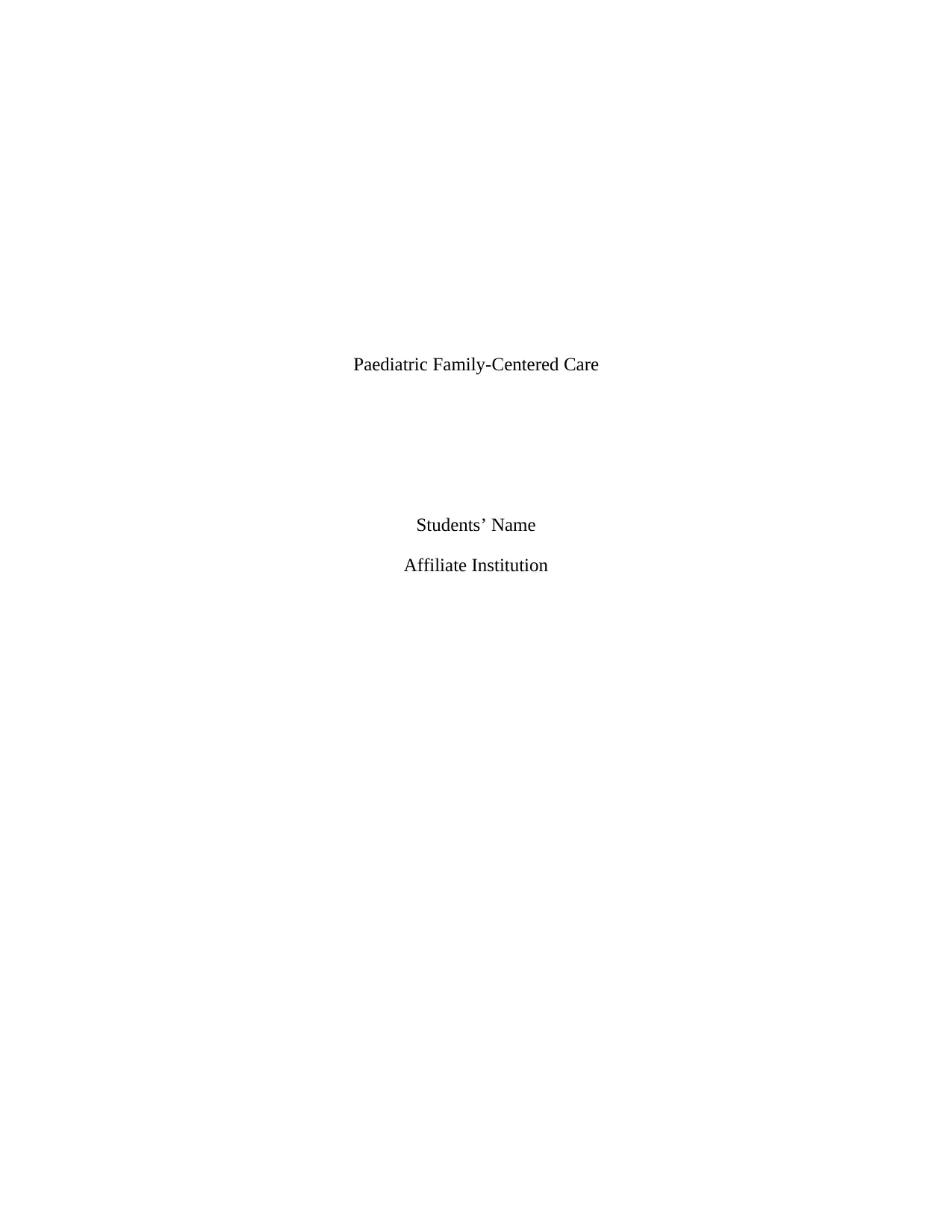
Paediatric Family-Centered Care
Students’ Name
Affiliate Institution
Students’ Name
Affiliate Institution
Paraphrase This Document
Need a fresh take? Get an instant paraphrase of this document with our AI Paraphraser

In recent years, there has been an immense change in Paediatric care. The trend toward
family-centered care for kids is based on an approach that respects and recognize family bond
values. The values enhance the psychological, emotional and physical health of children who are
given Paediatric treatment. There has been a revolution in family-centered care and to develop
the involvement of family members. There has been a growth in figures of parents who choose
Paediatric care that is an in-home and long-term for their kids who are facing medical challenges
(Vasli, Dehghan-Nayeri, Borim-Nezhad, & Vedadhir,2015).
According to American Academy of Pediatrics (2009) family-centred care is a method
that involves planning, providing and evaluating health care that is based on a relationship with
mutual benefits among health care practitioners, families and patients. There has to be a
relationship between the health practitioners and the family, who are the consumers. The health
professionals have come to appreciate the role family members play in ensuring that there is an
enhanced recovery among infants and children. Lindly, Zuckerman, and Mistry (2017) point out
that in health care, it is essential to receive emotional, social and development support which is
necessary.
The Institute for Family-Care points out that with family-centered care, is a method of
health care that programs, shape policies and facilitates the design of the health industry. Family-
centered care for children requires a change in the orientation of health services, where there is a
change from a model that is standard to one that is collaborative. The collaborative model
emphasizes the involvement of family which is integral to childcare.
Family-centered care involves a partnership between health care providers and family
members. This recognizes the unique cultures, values the opinions and beliefs of every family
who are involved in developing a plan for treatment and recovery.
The care begins by valuing and recognizing the significance of family members in
treatment and recuperation of children facing medical challenges. When family members are
kept present during treatment as asserted by American Academy of Pediatrics (2009),
stakeholder apprehension is lowered by Paediatricians through creating a family members
supportive setting, which promotes healing environment by boosting patient interaction. The
health practitioners must respect family members unique contribution.
family-centered care for kids is based on an approach that respects and recognize family bond
values. The values enhance the psychological, emotional and physical health of children who are
given Paediatric treatment. There has been a revolution in family-centered care and to develop
the involvement of family members. There has been a growth in figures of parents who choose
Paediatric care that is an in-home and long-term for their kids who are facing medical challenges
(Vasli, Dehghan-Nayeri, Borim-Nezhad, & Vedadhir,2015).
According to American Academy of Pediatrics (2009) family-centred care is a method
that involves planning, providing and evaluating health care that is based on a relationship with
mutual benefits among health care practitioners, families and patients. There has to be a
relationship between the health practitioners and the family, who are the consumers. The health
professionals have come to appreciate the role family members play in ensuring that there is an
enhanced recovery among infants and children. Lindly, Zuckerman, and Mistry (2017) point out
that in health care, it is essential to receive emotional, social and development support which is
necessary.
The Institute for Family-Care points out that with family-centered care, is a method of
health care that programs, shape policies and facilitates the design of the health industry. Family-
centered care for children requires a change in the orientation of health services, where there is a
change from a model that is standard to one that is collaborative. The collaborative model
emphasizes the involvement of family which is integral to childcare.
Family-centered care involves a partnership between health care providers and family
members. This recognizes the unique cultures, values the opinions and beliefs of every family
who are involved in developing a plan for treatment and recovery.
The care begins by valuing and recognizing the significance of family members in
treatment and recuperation of children facing medical challenges. When family members are
kept present during treatment as asserted by American Academy of Pediatrics (2009),
stakeholder apprehension is lowered by Paediatricians through creating a family members
supportive setting, which promotes healing environment by boosting patient interaction. The
health practitioners must respect family members unique contribution.
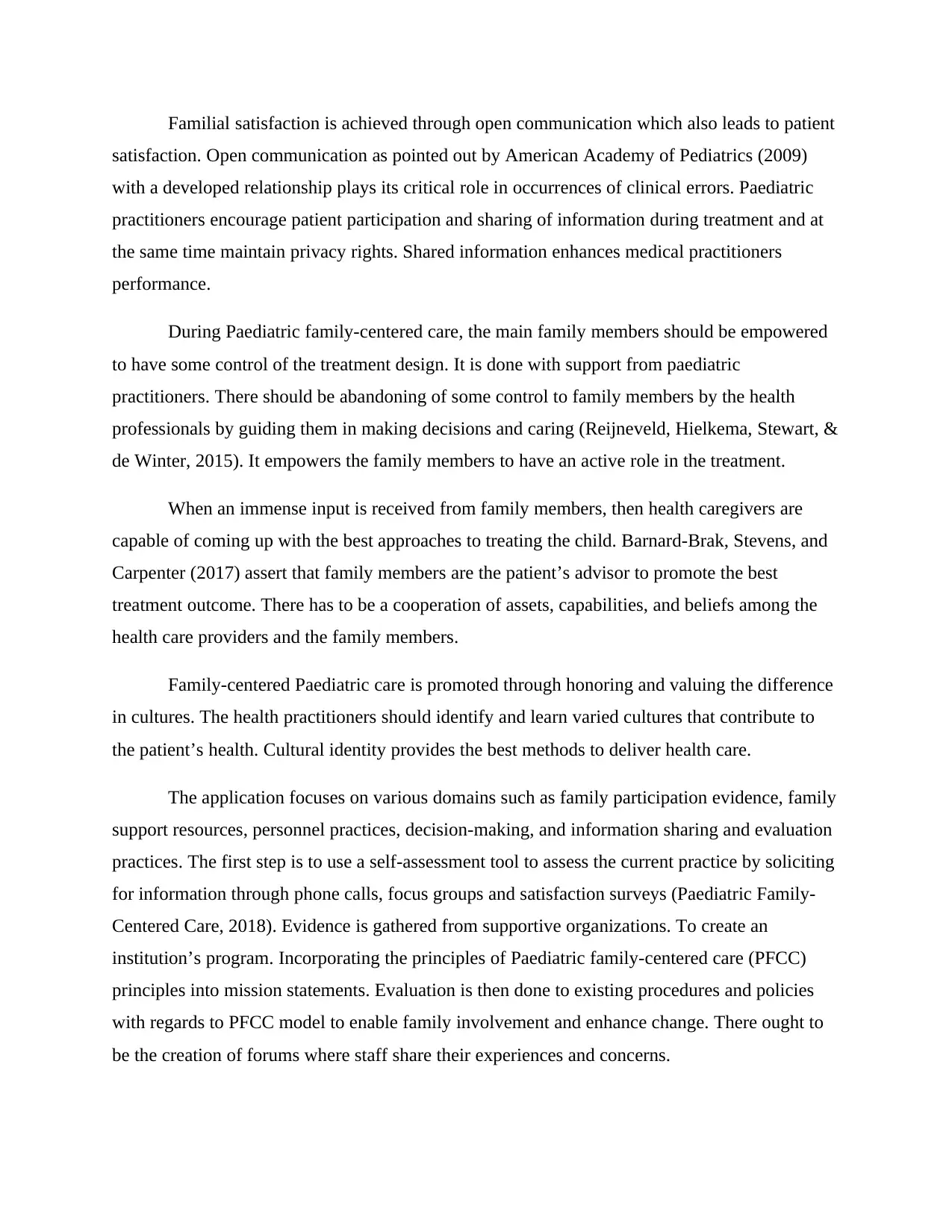
Familial satisfaction is achieved through open communication which also leads to patient
satisfaction. Open communication as pointed out by American Academy of Pediatrics (2009)
with a developed relationship plays its critical role in occurrences of clinical errors. Paediatric
practitioners encourage patient participation and sharing of information during treatment and at
the same time maintain privacy rights. Shared information enhances medical practitioners
performance.
During Paediatric family-centered care, the main family members should be empowered
to have some control of the treatment design. It is done with support from paediatric
practitioners. There should be abandoning of some control to family members by the health
professionals by guiding them in making decisions and caring (Reijneveld, Hielkema, Stewart, &
de Winter, 2015). It empowers the family members to have an active role in the treatment.
When an immense input is received from family members, then health caregivers are
capable of coming up with the best approaches to treating the child. Barnard-Brak, Stevens, and
Carpenter (2017) assert that family members are the patient’s advisor to promote the best
treatment outcome. There has to be a cooperation of assets, capabilities, and beliefs among the
health care providers and the family members.
Family-centered Paediatric care is promoted through honoring and valuing the difference
in cultures. The health practitioners should identify and learn varied cultures that contribute to
the patient’s health. Cultural identity provides the best methods to deliver health care.
The application focuses on various domains such as family participation evidence, family
support resources, personnel practices, decision-making, and information sharing and evaluation
practices. The first step is to use a self-assessment tool to assess the current practice by soliciting
for information through phone calls, focus groups and satisfaction surveys (Paediatric Family-
Centered Care, 2018). Evidence is gathered from supportive organizations. To create an
institution’s program. Incorporating the principles of Paediatric family-centered care (PFCC)
principles into mission statements. Evaluation is then done to existing procedures and policies
with regards to PFCC model to enable family involvement and enhance change. There ought to
be the creation of forums where staff share their experiences and concerns.
satisfaction. Open communication as pointed out by American Academy of Pediatrics (2009)
with a developed relationship plays its critical role in occurrences of clinical errors. Paediatric
practitioners encourage patient participation and sharing of information during treatment and at
the same time maintain privacy rights. Shared information enhances medical practitioners
performance.
During Paediatric family-centered care, the main family members should be empowered
to have some control of the treatment design. It is done with support from paediatric
practitioners. There should be abandoning of some control to family members by the health
professionals by guiding them in making decisions and caring (Reijneveld, Hielkema, Stewart, &
de Winter, 2015). It empowers the family members to have an active role in the treatment.
When an immense input is received from family members, then health caregivers are
capable of coming up with the best approaches to treating the child. Barnard-Brak, Stevens, and
Carpenter (2017) assert that family members are the patient’s advisor to promote the best
treatment outcome. There has to be a cooperation of assets, capabilities, and beliefs among the
health care providers and the family members.
Family-centered Paediatric care is promoted through honoring and valuing the difference
in cultures. The health practitioners should identify and learn varied cultures that contribute to
the patient’s health. Cultural identity provides the best methods to deliver health care.
The application focuses on various domains such as family participation evidence, family
support resources, personnel practices, decision-making, and information sharing and evaluation
practices. The first step is to use a self-assessment tool to assess the current practice by soliciting
for information through phone calls, focus groups and satisfaction surveys (Paediatric Family-
Centered Care, 2018). Evidence is gathered from supportive organizations. To create an
institution’s program. Incorporating the principles of Paediatric family-centered care (PFCC)
principles into mission statements. Evaluation is then done to existing procedures and policies
with regards to PFCC model to enable family involvement and enhance change. There ought to
be the creation of forums where staff share their experiences and concerns.
⊘ This is a preview!⊘
Do you want full access?
Subscribe today to unlock all pages.

Trusted by 1+ million students worldwide
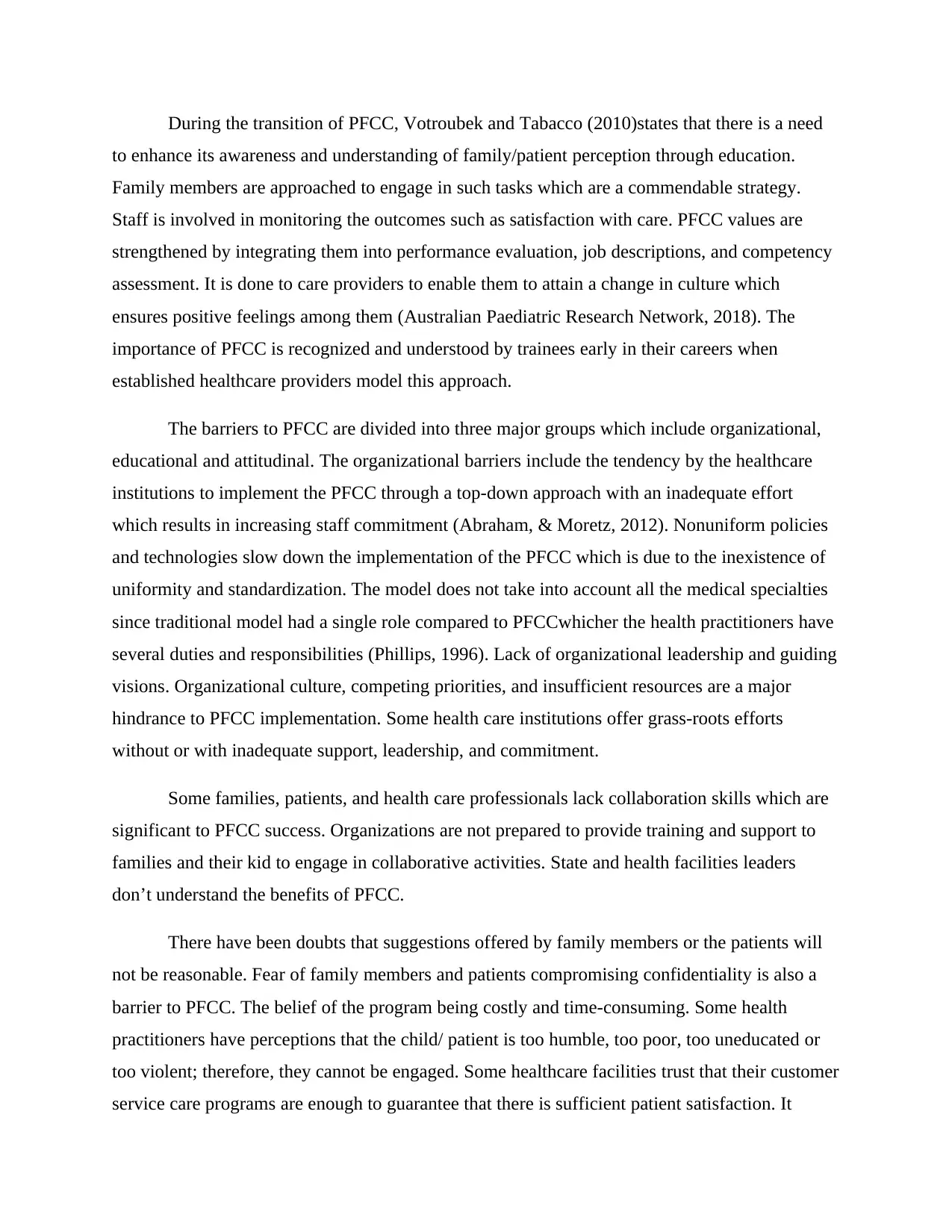
During the transition of PFCC, Votroubek and Tabacco (2010)states that there is a need
to enhance its awareness and understanding of family/patient perception through education.
Family members are approached to engage in such tasks which are a commendable strategy.
Staff is involved in monitoring the outcomes such as satisfaction with care. PFCC values are
strengthened by integrating them into performance evaluation, job descriptions, and competency
assessment. It is done to care providers to enable them to attain a change in culture which
ensures positive feelings among them (Australian Paediatric Research Network, 2018). The
importance of PFCC is recognized and understood by trainees early in their careers when
established healthcare providers model this approach.
The barriers to PFCC are divided into three major groups which include organizational,
educational and attitudinal. The organizational barriers include the tendency by the healthcare
institutions to implement the PFCC through a top-down approach with an inadequate effort
which results in increasing staff commitment (Abraham, & Moretz, 2012). Nonuniform policies
and technologies slow down the implementation of the PFCC which is due to the inexistence of
uniformity and standardization. The model does not take into account all the medical specialties
since traditional model had a single role compared to PFCCwhicher the health practitioners have
several duties and responsibilities (Phillips, 1996). Lack of organizational leadership and guiding
visions. Organizational culture, competing priorities, and insufficient resources are a major
hindrance to PFCC implementation. Some health care institutions offer grass-roots efforts
without or with inadequate support, leadership, and commitment.
Some families, patients, and health care professionals lack collaboration skills which are
significant to PFCC success. Organizations are not prepared to provide training and support to
families and their kid to engage in collaborative activities. State and health facilities leaders
don’t understand the benefits of PFCC.
There have been doubts that suggestions offered by family members or the patients will
not be reasonable. Fear of family members and patients compromising confidentiality is also a
barrier to PFCC. The belief of the program being costly and time-consuming. Some health
practitioners have perceptions that the child/ patient is too humble, too poor, too uneducated or
too violent; therefore, they cannot be engaged. Some healthcare facilities trust that their customer
service care programs are enough to guarantee that there is sufficient patient satisfaction. It
to enhance its awareness and understanding of family/patient perception through education.
Family members are approached to engage in such tasks which are a commendable strategy.
Staff is involved in monitoring the outcomes such as satisfaction with care. PFCC values are
strengthened by integrating them into performance evaluation, job descriptions, and competency
assessment. It is done to care providers to enable them to attain a change in culture which
ensures positive feelings among them (Australian Paediatric Research Network, 2018). The
importance of PFCC is recognized and understood by trainees early in their careers when
established healthcare providers model this approach.
The barriers to PFCC are divided into three major groups which include organizational,
educational and attitudinal. The organizational barriers include the tendency by the healthcare
institutions to implement the PFCC through a top-down approach with an inadequate effort
which results in increasing staff commitment (Abraham, & Moretz, 2012). Nonuniform policies
and technologies slow down the implementation of the PFCC which is due to the inexistence of
uniformity and standardization. The model does not take into account all the medical specialties
since traditional model had a single role compared to PFCCwhicher the health practitioners have
several duties and responsibilities (Phillips, 1996). Lack of organizational leadership and guiding
visions. Organizational culture, competing priorities, and insufficient resources are a major
hindrance to PFCC implementation. Some health care institutions offer grass-roots efforts
without or with inadequate support, leadership, and commitment.
Some families, patients, and health care professionals lack collaboration skills which are
significant to PFCC success. Organizations are not prepared to provide training and support to
families and their kid to engage in collaborative activities. State and health facilities leaders
don’t understand the benefits of PFCC.
There have been doubts that suggestions offered by family members or the patients will
not be reasonable. Fear of family members and patients compromising confidentiality is also a
barrier to PFCC. The belief of the program being costly and time-consuming. Some health
practitioners have perceptions that the child/ patient is too humble, too poor, too uneducated or
too violent; therefore, they cannot be engaged. Some healthcare facilities trust that their customer
service care programs are enough to guarantee that there is sufficient patient satisfaction. It
Paraphrase This Document
Need a fresh take? Get an instant paraphrase of this document with our AI Paraphraser
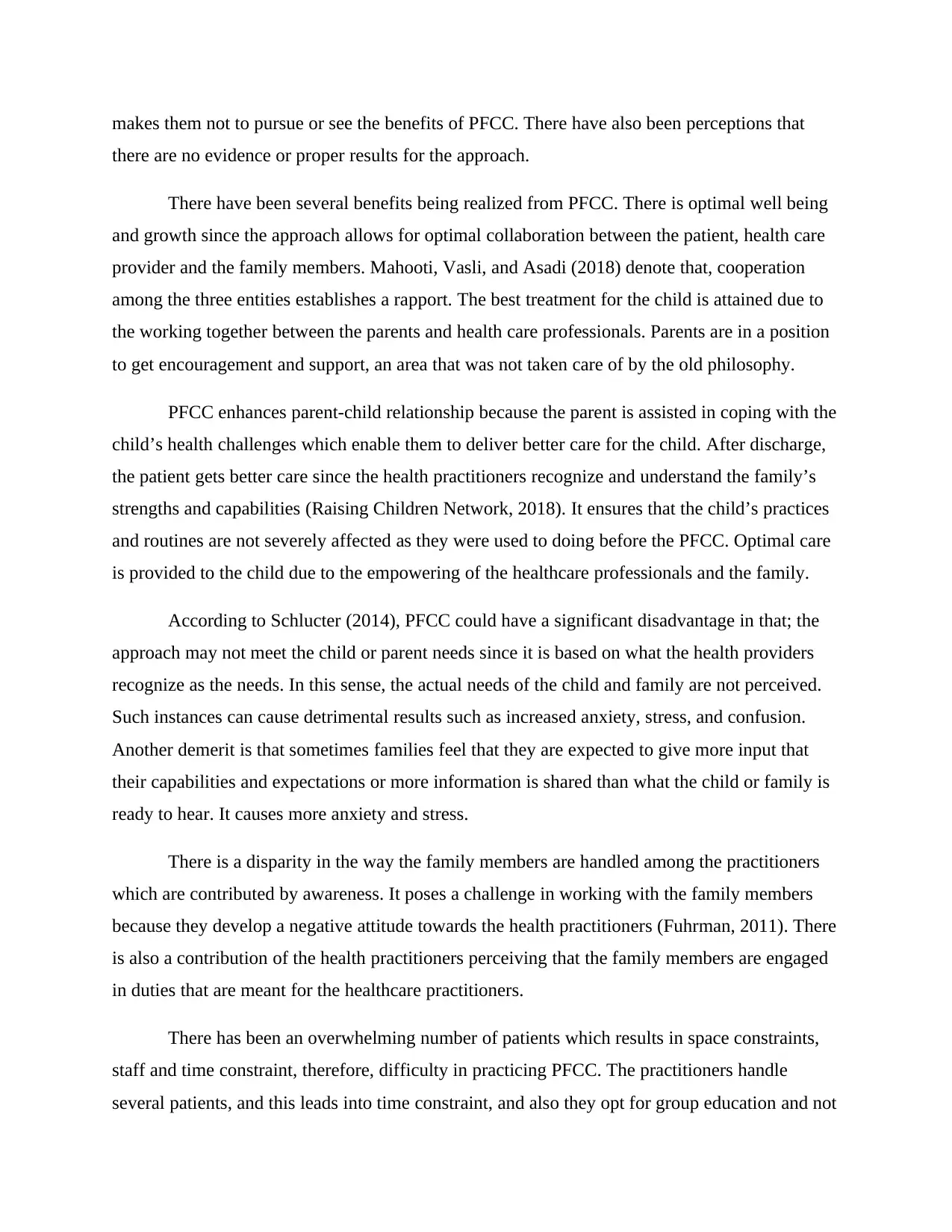
makes them not to pursue or see the benefits of PFCC. There have also been perceptions that
there are no evidence or proper results for the approach.
There have been several benefits being realized from PFCC. There is optimal well being
and growth since the approach allows for optimal collaboration between the patient, health care
provider and the family members. Mahooti, Vasli, and Asadi (2018) denote that, cooperation
among the three entities establishes a rapport. The best treatment for the child is attained due to
the working together between the parents and health care professionals. Parents are in a position
to get encouragement and support, an area that was not taken care of by the old philosophy.
PFCC enhances parent-child relationship because the parent is assisted in coping with the
child’s health challenges which enable them to deliver better care for the child. After discharge,
the patient gets better care since the health practitioners recognize and understand the family’s
strengths and capabilities (Raising Children Network, 2018). It ensures that the child’s practices
and routines are not severely affected as they were used to doing before the PFCC. Optimal care
is provided to the child due to the empowering of the healthcare professionals and the family.
According to Schlucter (2014), PFCC could have a significant disadvantage in that; the
approach may not meet the child or parent needs since it is based on what the health providers
recognize as the needs. In this sense, the actual needs of the child and family are not perceived.
Such instances can cause detrimental results such as increased anxiety, stress, and confusion.
Another demerit is that sometimes families feel that they are expected to give more input that
their capabilities and expectations or more information is shared than what the child or family is
ready to hear. It causes more anxiety and stress.
There is a disparity in the way the family members are handled among the practitioners
which are contributed by awareness. It poses a challenge in working with the family members
because they develop a negative attitude towards the health practitioners (Fuhrman, 2011). There
is also a contribution of the health practitioners perceiving that the family members are engaged
in duties that are meant for the healthcare practitioners.
There has been an overwhelming number of patients which results in space constraints,
staff and time constraint, therefore, difficulty in practicing PFCC. The practitioners handle
several patients, and this leads into time constraint, and also they opt for group education and not
there are no evidence or proper results for the approach.
There have been several benefits being realized from PFCC. There is optimal well being
and growth since the approach allows for optimal collaboration between the patient, health care
provider and the family members. Mahooti, Vasli, and Asadi (2018) denote that, cooperation
among the three entities establishes a rapport. The best treatment for the child is attained due to
the working together between the parents and health care professionals. Parents are in a position
to get encouragement and support, an area that was not taken care of by the old philosophy.
PFCC enhances parent-child relationship because the parent is assisted in coping with the
child’s health challenges which enable them to deliver better care for the child. After discharge,
the patient gets better care since the health practitioners recognize and understand the family’s
strengths and capabilities (Raising Children Network, 2018). It ensures that the child’s practices
and routines are not severely affected as they were used to doing before the PFCC. Optimal care
is provided to the child due to the empowering of the healthcare professionals and the family.
According to Schlucter (2014), PFCC could have a significant disadvantage in that; the
approach may not meet the child or parent needs since it is based on what the health providers
recognize as the needs. In this sense, the actual needs of the child and family are not perceived.
Such instances can cause detrimental results such as increased anxiety, stress, and confusion.
Another demerit is that sometimes families feel that they are expected to give more input that
their capabilities and expectations or more information is shared than what the child or family is
ready to hear. It causes more anxiety and stress.
There is a disparity in the way the family members are handled among the practitioners
which are contributed by awareness. It poses a challenge in working with the family members
because they develop a negative attitude towards the health practitioners (Fuhrman, 2011). There
is also a contribution of the health practitioners perceiving that the family members are engaged
in duties that are meant for the healthcare practitioners.
There has been an overwhelming number of patients which results in space constraints,
staff and time constraint, therefore, difficulty in practicing PFCC. The practitioners handle
several patients, and this leads into time constraint, and also they opt for group education and not

individualized patient education. There have been cases where parents are not in a position to
access essential facilities like beds, forcing them not to sleep with their children in the health
facilities.
Parental commitments serve as a major challenge. Social responsibilities and parent
obligations limit them from being available with the hospitalized kid especially single parents
(The Royal Australasian College of Physicians, 2018). The parental responsibilities cause
anxiety among parents hence they aren’t able to concentrate while being educated or advised.
There has been parental fear of seeing or witnessing some medical procedures. Traumatic
parents are not in a position to accompany their children during certain procedures; hence they
opt away leaving them with the health professionals. Glasper (2015) states that when parents
walk away due to fear, carrying out traumatic care to the child becomes an uphill task.
Procedures like lumbar puncture and resuscitation cause parents to walk away and pulling some
back is not easy.
Parental behavior caused by cultural influences makes parents have varied wired thoughts
towards PFCC. Cultural influence makes some parents present their sick children differently to
the health facilities (The Royal Children's Hospital Melbourne, 2018). In most cultures, issues to
do with children’s health care is left to the mothers which pose further challenges.
Paediatric Family-Centered Care emphasizes that in a child’s health care, the family
remains to be constant while the health professionals and service systems fluctuate. PFCC
guarantees that the family is provided with information concerning their child’s health progress
in a manner that is continuous and supportive. It also takes note of identifying and honoring
strength, diversity, and individuality across and within families including social, economic,
racial, spiritual and geographical diversity (Child and Family-Centred Care, 2018). The family is
needed to implement comprehensive programs and policies that offer support to accomplish the
broad child health care needs.
PFCC has changed the way health institutions provide health care to the young ones; it
has decreased costs, improved patient outcomes, and enhanced staff satisfaction. Various
healthcare facilities make their PFCC principles, but all of them recognize critical values by
identifying the significance of family members’ roles. Healthcare facilities that have endorsed
access essential facilities like beds, forcing them not to sleep with their children in the health
facilities.
Parental commitments serve as a major challenge. Social responsibilities and parent
obligations limit them from being available with the hospitalized kid especially single parents
(The Royal Australasian College of Physicians, 2018). The parental responsibilities cause
anxiety among parents hence they aren’t able to concentrate while being educated or advised.
There has been parental fear of seeing or witnessing some medical procedures. Traumatic
parents are not in a position to accompany their children during certain procedures; hence they
opt away leaving them with the health professionals. Glasper (2015) states that when parents
walk away due to fear, carrying out traumatic care to the child becomes an uphill task.
Procedures like lumbar puncture and resuscitation cause parents to walk away and pulling some
back is not easy.
Parental behavior caused by cultural influences makes parents have varied wired thoughts
towards PFCC. Cultural influence makes some parents present their sick children differently to
the health facilities (The Royal Children's Hospital Melbourne, 2018). In most cultures, issues to
do with children’s health care is left to the mothers which pose further challenges.
Paediatric Family-Centered Care emphasizes that in a child’s health care, the family
remains to be constant while the health professionals and service systems fluctuate. PFCC
guarantees that the family is provided with information concerning their child’s health progress
in a manner that is continuous and supportive. It also takes note of identifying and honoring
strength, diversity, and individuality across and within families including social, economic,
racial, spiritual and geographical diversity (Child and Family-Centred Care, 2018). The family is
needed to implement comprehensive programs and policies that offer support to accomplish the
broad child health care needs.
PFCC has changed the way health institutions provide health care to the young ones; it
has decreased costs, improved patient outcomes, and enhanced staff satisfaction. Various
healthcare facilities make their PFCC principles, but all of them recognize critical values by
identifying the significance of family members’ roles. Healthcare facilities that have endorsed
⊘ This is a preview!⊘
Do you want full access?
Subscribe today to unlock all pages.

Trusted by 1+ million students worldwide

PFCC to be part of its culture get results of not only the satisfaction of family, patient, and staff
but also an improvement in the patients’ health outcome. There is a correlation between PFCC
implementation and faster patient recovery, reducing in the use of healthcare resources and a
decrease in patient emergency case.
Paediatricians and health facilities that practice PFCC improve clinical decision-making
through appropriate information and collaborative processes. They also experience a competitive
advantage in the healthcare industry and enhance child and family satisfaction. PFC ensures that
there is child health development that is promoted by the family through a strong alliance.
but also an improvement in the patients’ health outcome. There is a correlation between PFCC
implementation and faster patient recovery, reducing in the use of healthcare resources and a
decrease in patient emergency case.
Paediatricians and health facilities that practice PFCC improve clinical decision-making
through appropriate information and collaborative processes. They also experience a competitive
advantage in the healthcare industry and enhance child and family satisfaction. PFC ensures that
there is child health development that is promoted by the family through a strong alliance.
Paraphrase This Document
Need a fresh take? Get an instant paraphrase of this document with our AI Paraphraser
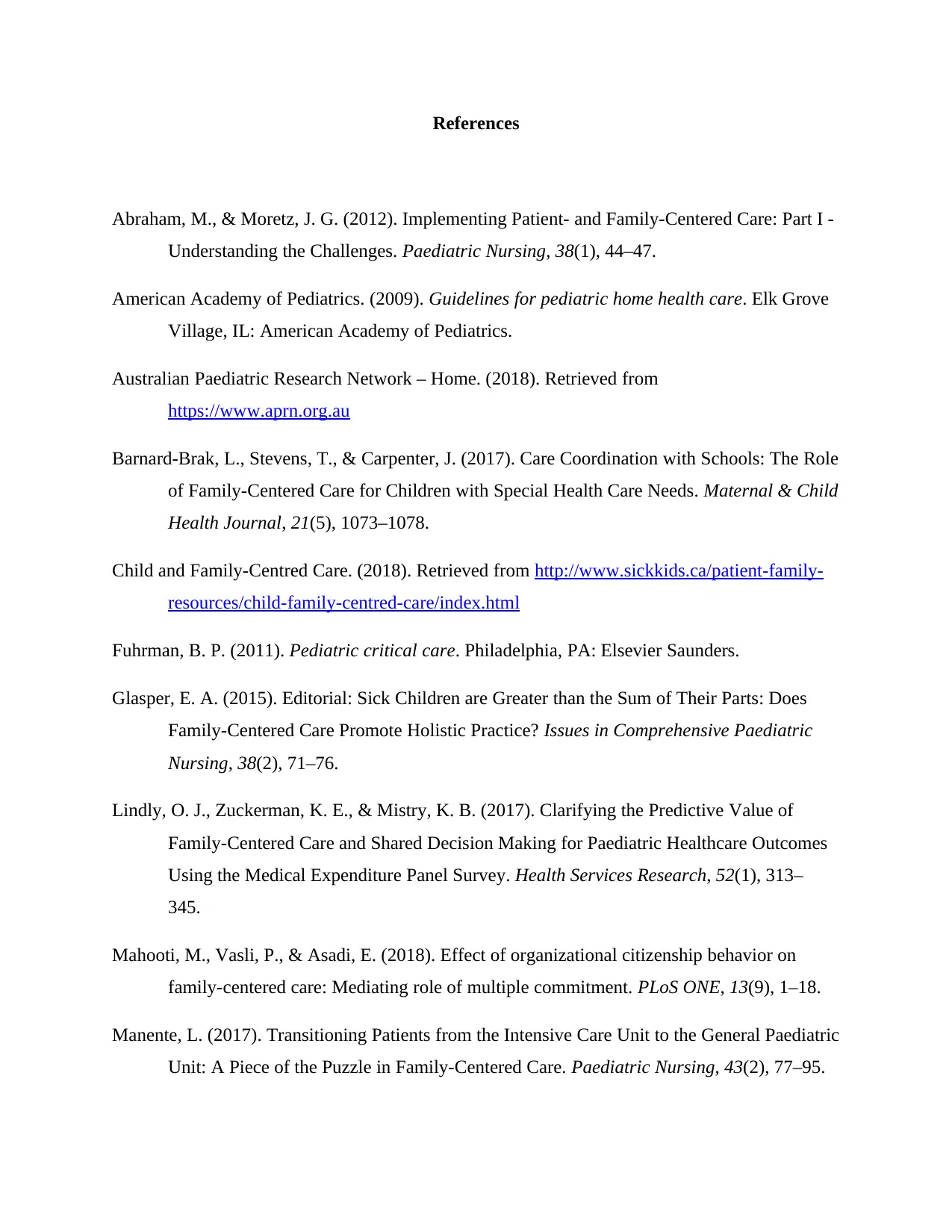
References
Abraham, M., & Moretz, J. G. (2012). Implementing Patient- and Family-Centered Care: Part I -
Understanding the Challenges. Paediatric Nursing, 38(1), 44–47.
American Academy of Pediatrics. (2009). Guidelines for pediatric home health care. Elk Grove
Village, IL: American Academy of Pediatrics.
Australian Paediatric Research Network – Home. (2018). Retrieved from
https://www.aprn.org.au
Barnard-Brak, L., Stevens, T., & Carpenter, J. (2017). Care Coordination with Schools: The Role
of Family-Centered Care for Children with Special Health Care Needs. Maternal & Child
Health Journal, 21(5), 1073–1078.
Child and Family-Centred Care. (2018). Retrieved from http://www.sickkids.ca/patient-family-
resources/child-family-centred-care/index.html
Fuhrman, B. P. (2011). Pediatric critical care. Philadelphia, PA: Elsevier Saunders.
Glasper, E. A. (2015). Editorial: Sick Children are Greater than the Sum of Their Parts: Does
Family-Centered Care Promote Holistic Practice? Issues in Comprehensive Paediatric
Nursing, 38(2), 71–76.
Lindly, O. J., Zuckerman, K. E., & Mistry, K. B. (2017). Clarifying the Predictive Value of
Family-Centered Care and Shared Decision Making for Paediatric Healthcare Outcomes
Using the Medical Expenditure Panel Survey. Health Services Research, 52(1), 313–
345.
Mahooti, M., Vasli, P., & Asadi, E. (2018). Effect of organizational citizenship behavior on
family-centered care: Mediating role of multiple commitment. PLoS ONE, 13(9), 1–18.
Manente, L. (2017). Transitioning Patients from the Intensive Care Unit to the General Paediatric
Unit: A Piece of the Puzzle in Family-Centered Care. Paediatric Nursing, 43(2), 77–95.
Abraham, M., & Moretz, J. G. (2012). Implementing Patient- and Family-Centered Care: Part I -
Understanding the Challenges. Paediatric Nursing, 38(1), 44–47.
American Academy of Pediatrics. (2009). Guidelines for pediatric home health care. Elk Grove
Village, IL: American Academy of Pediatrics.
Australian Paediatric Research Network – Home. (2018). Retrieved from
https://www.aprn.org.au
Barnard-Brak, L., Stevens, T., & Carpenter, J. (2017). Care Coordination with Schools: The Role
of Family-Centered Care for Children with Special Health Care Needs. Maternal & Child
Health Journal, 21(5), 1073–1078.
Child and Family-Centred Care. (2018). Retrieved from http://www.sickkids.ca/patient-family-
resources/child-family-centred-care/index.html
Fuhrman, B. P. (2011). Pediatric critical care. Philadelphia, PA: Elsevier Saunders.
Glasper, E. A. (2015). Editorial: Sick Children are Greater than the Sum of Their Parts: Does
Family-Centered Care Promote Holistic Practice? Issues in Comprehensive Paediatric
Nursing, 38(2), 71–76.
Lindly, O. J., Zuckerman, K. E., & Mistry, K. B. (2017). Clarifying the Predictive Value of
Family-Centered Care and Shared Decision Making for Paediatric Healthcare Outcomes
Using the Medical Expenditure Panel Survey. Health Services Research, 52(1), 313–
345.
Mahooti, M., Vasli, P., & Asadi, E. (2018). Effect of organizational citizenship behavior on
family-centered care: Mediating role of multiple commitment. PLoS ONE, 13(9), 1–18.
Manente, L. (2017). Transitioning Patients from the Intensive Care Unit to the General Paediatric
Unit: A Piece of the Puzzle in Family-Centered Care. Paediatric Nursing, 43(2), 77–95.
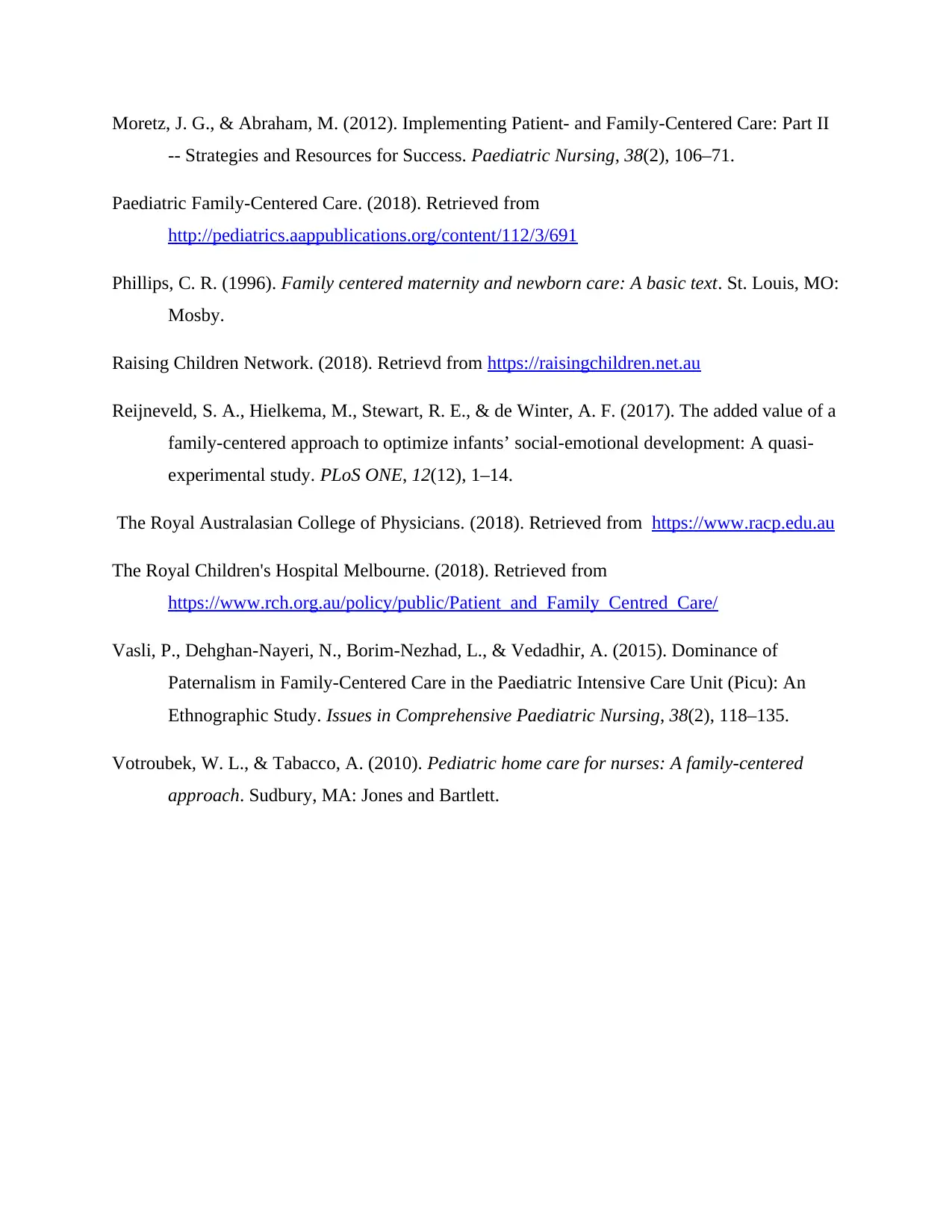
Moretz, J. G., & Abraham, M. (2012). Implementing Patient- and Family-Centered Care: Part II
-- Strategies and Resources for Success. Paediatric Nursing, 38(2), 106–71.
Paediatric Family-Centered Care. (2018). Retrieved from
http://pediatrics.aappublications.org/content/112/3/691
Phillips, C. R. (1996). Family centered maternity and newborn care: A basic text. St. Louis, MO:
Mosby.
Raising Children Network. (2018). Retrievd from https://raisingchildren.net.au
Reijneveld, S. A., Hielkema, M., Stewart, R. E., & de Winter, A. F. (2017). The added value of a
family-centered approach to optimize infants’ social-emotional development: A quasi-
experimental study. PLoS ONE, 12(12), 1–14.
The Royal Australasian College of Physicians. (2018). Retrieved from https://www.racp.edu.au
The Royal Children's Hospital Melbourne. (2018). Retrieved from
https://www.rch.org.au/policy/public/Patient_and_Family_Centred_Care/
Vasli, P., Dehghan-Nayeri, N., Borim-Nezhad, L., & Vedadhir, A. (2015). Dominance of
Paternalism in Family-Centered Care in the Paediatric Intensive Care Unit (Picu): An
Ethnographic Study. Issues in Comprehensive Paediatric Nursing, 38(2), 118–135.
Votroubek, W. L., & Tabacco, A. (2010). Pediatric home care for nurses: A family-centered
approach. Sudbury, MA: Jones and Bartlett.
-- Strategies and Resources for Success. Paediatric Nursing, 38(2), 106–71.
Paediatric Family-Centered Care. (2018). Retrieved from
http://pediatrics.aappublications.org/content/112/3/691
Phillips, C. R. (1996). Family centered maternity and newborn care: A basic text. St. Louis, MO:
Mosby.
Raising Children Network. (2018). Retrievd from https://raisingchildren.net.au
Reijneveld, S. A., Hielkema, M., Stewart, R. E., & de Winter, A. F. (2017). The added value of a
family-centered approach to optimize infants’ social-emotional development: A quasi-
experimental study. PLoS ONE, 12(12), 1–14.
The Royal Australasian College of Physicians. (2018). Retrieved from https://www.racp.edu.au
The Royal Children's Hospital Melbourne. (2018). Retrieved from
https://www.rch.org.au/policy/public/Patient_and_Family_Centred_Care/
Vasli, P., Dehghan-Nayeri, N., Borim-Nezhad, L., & Vedadhir, A. (2015). Dominance of
Paternalism in Family-Centered Care in the Paediatric Intensive Care Unit (Picu): An
Ethnographic Study. Issues in Comprehensive Paediatric Nursing, 38(2), 118–135.
Votroubek, W. L., & Tabacco, A. (2010). Pediatric home care for nurses: A family-centered
approach. Sudbury, MA: Jones and Bartlett.
⊘ This is a preview!⊘
Do you want full access?
Subscribe today to unlock all pages.

Trusted by 1+ million students worldwide
1 out of 9
Related Documents
Your All-in-One AI-Powered Toolkit for Academic Success.
+13062052269
info@desklib.com
Available 24*7 on WhatsApp / Email
![[object Object]](/_next/static/media/star-bottom.7253800d.svg)
Unlock your academic potential
Copyright © 2020–2025 A2Z Services. All Rights Reserved. Developed and managed by ZUCOL.





